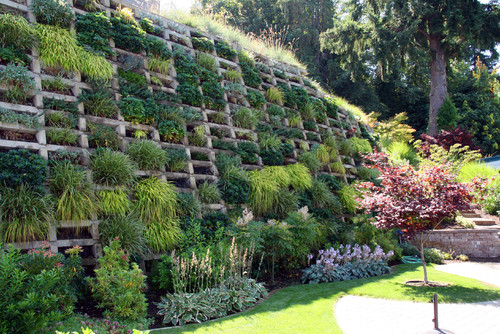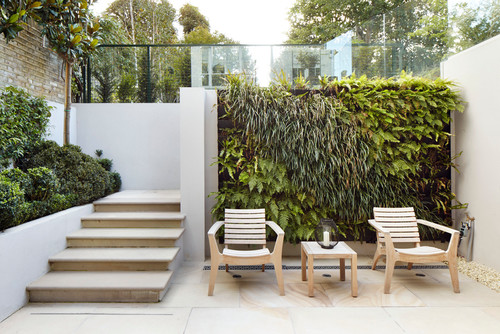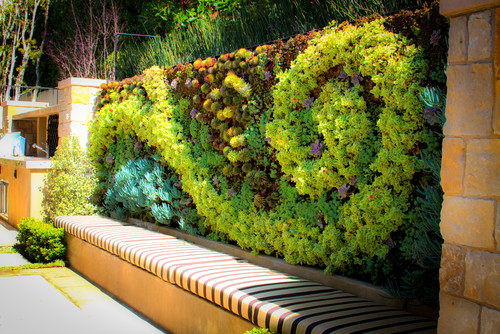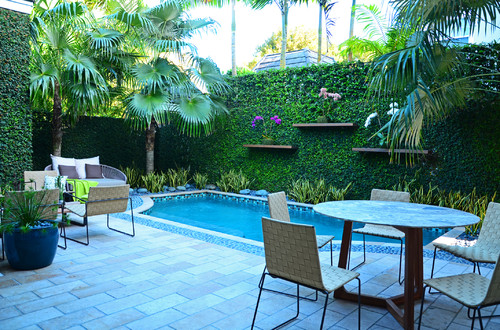Outdoor Living Walls: Ideas + Inspiration {Guide}

Living walls, otherwise known as vertical gardens or green walls, are trending in landscape design as ways to elevate plants from ground level to eye level and beyond. They also camouflage walls, act as art and generate a peaceful feel.
Homeowners and their designers have been able to incorporate living walls into even the most unexpected spaces, giving homeowners plenty inspiration when it comes to greening up own outdoor living areas. Read on to see outdoor living wall ideas and benefits!
What is a Living Wall?
A living wall is a wall with living plants and greenery occupying the surface. They can have built-in irrigation or other systems to help with plant health and growth. They can help to liven a dull indoor or outdoor space with relatively minimal effort. Outdoor living walls are also commonly known as green walls, vertical gardens, or living green walls.
Benefits of Living Walls
Studies have shown that living walls can actually increase the number of patrons in restaurants, hotels, shops and other businesses compared to those lacking this type of garden. Presence of plants makes people feel less stressed which means that, subconsciously or not, they’ll wind up staying longer in a place of business which often equates to increased sales.
The same goes for household use. Experts suspect that the zen feeling green walls lend to residents and visitors can potentially raise the value of a home.
From a practical standpoint, green walls can be gorgeous works of art. They dampen sound and temper heat. The insulation factor can help decrease use of heating and air depending on the size of the wall but plants can also cool areas they are in.
Of course, plants also help remove toxins from the air so generally having them where none existed before is always a benefit.
Best Plants for Living Walls —
The types of plants you choose obviously depends on the desired look and weight the living wall frame can tolerate. Generally, the plant types below are the most popular.
Succulents
Echeveria or small rosette succulents tend to handle life on a green wall fairly well. Some sedums can tolerate this style of planting and can be a great way to add in color. The trick to keeping succulents happy while vertical is making sure to use a cactus planting mix and letting it dry out completely before watering again. The fact that succulents don’t need much water, have tiny root systems and can easily be cut and transplanted make them excellent choices for living walls of all sizes.
Pretty Foliage
Plants with leaves that vary in color or have unusual shapes add visual interest to green walls. It’s rather easy to add yellow, blue, red and lime to a standard green wall too. Big frames can even handle huge-leafed plants like elephant ears.
Seasonal Color
In living walls where popping plants in and out is relatively easy, some homeowners dial up the orange in fall, red during Christmas and pastels around Easter. This is a good reason to think about the kind of flexibility needed before settling on a final design.
Living Wall Design Ideas —
You know you want a living wall but aren’t sure how to incorporate it or what it should look like? Check out these awesome green wall ideas.
The Lush Look
A rather wide variety of tropical plants can grow beautifully on a living wall. If you’re looking to make your backyard more like a Hawaiian getaway, this is a great solution. Bromeliads are relatively easy-care tropical plants with low water requirements that do well in Southern California gardens. However, when building an entire wall, make sure types used (there are thousands) can handle the same amount of sunlight.
Mailboxes and Light Posts
Cover a small structure like a built-in mailbox or light post with vertical gardens along the sides and top. You can see that the “roof” of this structure is merely little pots of plants, making it easy to swap them out when need be. Something this simple can really stand out as a point of interest.
Use Existing Walls
Some plants like small echeveria succulents have root systems that are so small they can grow in cracks and crevices. But, should you want larger plants to cover a space, covering an area like this with a wire lattice will enable hanging of felt pockets, popular mechanisms for vertical plantings. Some homeowners aim to cover the entire lattice with plants while others like the industrial look of it exposed.
Lush Seating
Bench seating is now often accented with entirely green walls or perhaps a few framed vertical gardens (better if you suspect guests will lean back while seated). However, this living wall stands out also because of the stunning planting pattern using vibrant colors.
Air Plant Art
The homeowner above attached air plants (tillandsias) to a wall in a gorgeous and artistic manner. Air plants do not need dirt in order to survive but they do derive nutrients from air and water. They can be attached to walls using a special waterproof adhesive or by using hooks to hold them in place.
Note that in Southern California gardens, air plants may do best in shade and with occasional misting unless the environment is naturally humid.
Dividing Walls
Need to wall off a space or create some privacy? Forget a stucco wall (it’s probably more expensive anyway) and opt for a lovely green wall instead. This one has about six inches of potting soil contained behind the plants which is enough to plant small succulents on both sides.
Climbing Vines and Hedge Walls
Climbing vines are another easy way to create living walls in a yard. Stay away from aggressive vines like English ivy which can root in walls and cause damage. Boston ivy and Virginia creeper are good options. Boxwood is the most popular way to create a hedge wall.
Framed Walls
Liven up a blank space with a framed vertical garden inside and outside of the home. The version above features pocket installation which means that plants can easily be swapped in and out. The cascading succulents create a stunning dramatic effect.
Your Turn…
How do you incorporate a living or green wall into your garden?
Frequently Asked Questions About Living Walls
How long do living walls last?
The length a living wall will last depends on how well it is taken care of. Like all plants, they thrive and deteriorate under similar circumstances. Depending on the plants you use on your vertical garden, you can expect to get 6 months to a year out of it before needing to replace the plants.
How much do living walls cost?
The cost of a living wall will come down to what kind of plants you use, whether there is a built-in irrigation system, and also if the wall will be sun-facing.
What are the disadvantages of living walls?
Living walls or vertical gardens have many advantages, but also come with some disadvantages (depending on how green your thumb is). First, they can be difficult to maintain and properly water since gravity is not kind to living walls. Second, they can be maintenance-heavy compared to a horizontal garden.
Top photo credit: Flickr/Jose Saez









